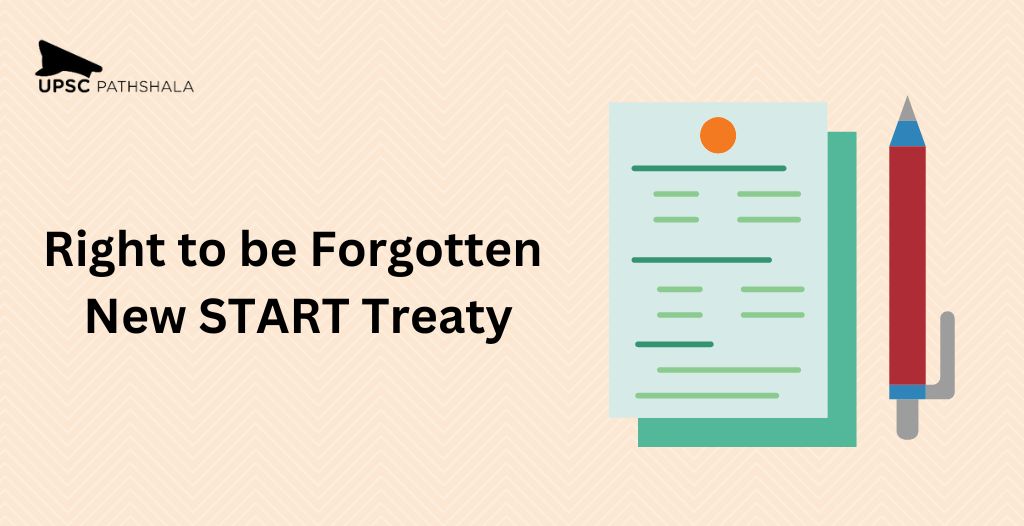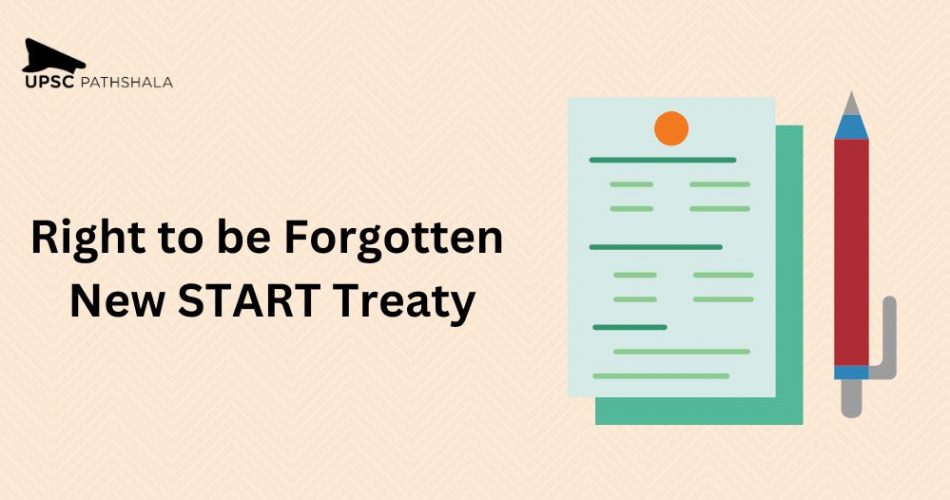Right to be Forgotten
Theme: Indian Constitution; Fundamental Rights; Judgements
Source: The Indian Express
Why in news: The Delhi High Court is all set to hear a doctor’s plea for enforcement of his ‘Right to be Forgotten’ to remove all irrelevant news content causing detriment to his life and personal liberty.

What is the case about?
Dr. Ishwarprasad Gilda vs. Union of India & Others:
- In this case, a practicing doctor was accused of offenses under the Indian Penal Code (IPC)
- Section 304A – causing death by negligence
- Section 417 – cheating
- Section 170 – personating a public servant
- The doctor was accused of illegally procuring medicines from abroad and administering them to HIV patients in India.
- The doctor approached the Delhi High Court seeking directions to remove all irrelevant news content causing “grave injury” to his reputation or to pass any other order to safeguard his dignity, including availing his Right to be Forgotten.
Also Read: Daily Current Affairs | Prelims Bits | 27th Feb
What is the Right to be Forgotten?
- The “Right to be Forgotten” is the right to remove or erase content so that it’s not accessible to the public at large.
- It empowers an individual to have information in the form of news, video, or photographs deleted from internet records so it doesn’t show up through search engines, like Google.
- The Right to be Forgotten originates from the 2014 European Court of Justice.
- Thereafter, it was included in the EU’s General Data Protection Regulation (GDPR) in addition to the right to erasure.
- In the Indian context, the Supreme Court in Puttaswamy v. Union of India, 2017 noted that the RTBF was a part of the broader right of privacy.
- The RTBF emerges from the right to privacy under Article 21 and partly from the right to dignity under Article 21.
What is the law on the Right to be Forgotten?
- Section 43A of the IT Act, 2000:
- It says that organizations who possess sensitive personal data and fail to maintain appropriate security to safeguard such data, may be obligated to pay damages to the affected person.
- IT Rules, 2021:
- It does not include this right.
- However, it lays down the procedure for filing complaints with the designated Grievance Officer to have content exposing personal information about a complainant removed from the internet.
- Personal Data Protection Bill:
- The Ministry of Electronics and Information Technology introduced the Personal Data Protection Bill in the Lok Sabha.
- Clause 20 under Chapter V of the draft bill mentions the Right to be Forgotten as the right to restrict or prevent the continuing disclosure of personal data by a data fiduciary.
What have the courts said so far?
- The right is not recognized by a law or a statute in India expressly.
- The courts have repeatedly held it to be endemic to an individual’s Right to Privacy under Article 21.
- The Supreme Court in K.S.Puttaswamy vs UOI referred to the European Union Regulation of 2016 which recognized the right to be forgotten as an individual’s right to remove personal information from the system.
- However, the court also recognized that such a right can be restricted by the right to freedom of expression and information or for compliance with legal obligations.
Static Part to be referred: Right to be Forgotten; Right to Privacy; Fundamental Rights;
Practice Mains Question:
| What is the right to be forgotten and how is it related to the right to privacy? Examine the issues related to the implementation of the right to be forgotten. (150 words, 10 marks) |
Also Read: Daily Current Affairs | Manual Scavenging | 27th Feb
New START treaty
Theme: International Treaties and Agreements
Source: The Hindu
Why in news: President Vladimir Putin announced Russia is suspending its participation in the New START, the last remaining major military agreement with the United States.

What was the background of the nuclear arms treaty between the U.S and Russia?
- In the initial decades of the Cold War, both Moscow and Washington were aggressive in their one-upmanship of expanding nuclear arsenals engaged in bilateral talks to keep checks on each other’s nuclear arsenals.
- The first formal dialogue, the Strategic Arms Limitation Talks (SALT), started between the two countries in 1969.
- The Anti-Ballistic Missile defence systems Treaty, which provided for the shooting down of incoming missiles, was signed in 1972, but the George W. Bush administration unilaterally pulled out of the pact in 2002.
- The Strategic Arms Reduction Treaty (START I), signed in 1991, expired in late 2009 and another treaty, the Strategic Offensive Reductions Treaty (SORT or Moscow Treaty), was signed in 2002. It never entered into force, and the START III treaty, for which negotiations were never concluded.
What is the New START nuclear treaty?
- The New START treaty replaced the 2002 pact and was the last remaining nuclear weapons control agreement between the two powers who together hold 90% of the world’s nuclear arsenal.
- The New START treaty was signed in 2010 by the former U.S. President Barack Obama and Russian President Dmitry Medve dev and came into force in February 2011.
- The treaty gave both countries seven years to reduce their stockpiles including nuclear warheads.
- In 2018, both nations met the arms limits prescribed by the treaty.
Treaty Duration:
- The treaty’s original duration was 10 years (until February 5, 2021), with the option for the Parties to agree to extend it for up to an additional five years.
- The United States and Russian Federation agreed on a five-year extension of New START to keep it in force through February 4, 2026.
What limits did the New START impose on the two countries?
- Number of strategic nuclear missile launchers will be reduced by half.
- A new inspection and verification regime will be established, replacing the SORT mechanism.
- The number of deployed strategic nuclear warheads is limited to 1,550.
- Number of deployed and non-deployed inter-continental ballistic missile (ICBM) launchers, submarine-launched ballistic missile (SLBM) launchers, and heavy bombers equipped for nuclear armaments to 800 will be limited.
How is compliance with the treaty ensured?
- It allows each side to carry out up to 18 short notice (32 hours) on site inspections of strategic nuclear weapons sites annually to ensure that the other country had not crossed the limits of the treaty.
- Under the agreement, Russia and the U.S. exchange data twice a year on ballistic missiles under the treaty’s purview and on bombers, test sites, nuclear bases etc.
- The treaty also mandates the two parties to send notifications within five days if they change or update something in their stockpile, like moving missiles to a new base or deploying a new warhead to the system.
Will it trigger an arms race?
- Russia has not withdrawn from the treaty, it just suspended it, which is the term not defined in the official pact.
- The analysts informed that it would not immediately trigger an arms race between the two powers.
- The Russian administration also announced that it does not plan to breach the limits on warheads prescribed in New START.
- Russia’s move is linked to the Ukraine conflict in opposition to the involvement of the West through financial and military aid.
Static Part to be covered: New START treaty; Nuclear Weapons
Practice Mains Question:
| What is the New START nuclear treaty? What does the suspension mean for global arms control? (150 words, 10 marks) |
Also Read: Daily Current Affairs | Heat wave | 27th Feb







